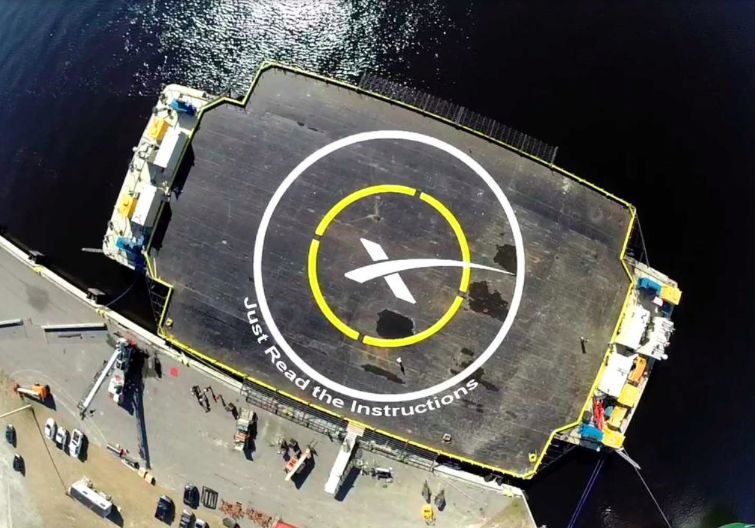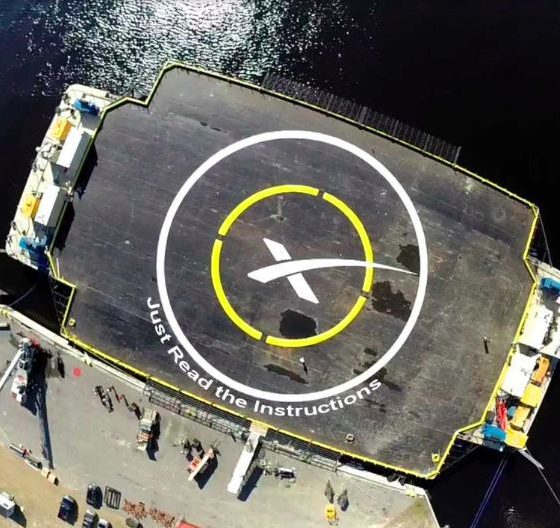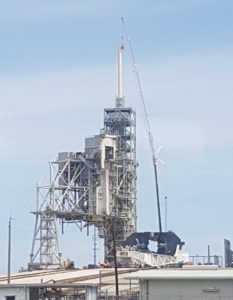

News
SpaceX to demonstrate weekly launch cadence: 3 launches in 14 days

LC-39A undergoing repairs and tests after the launch of CRS-11. (/r/SpaceX)
SpaceX is in the process of preparing to launch BulgariaSat-1, with the first attempt scheduled for Saturday, June 17th between 2:10 p.m and 4:10 p.m. EST. BulgariaSat-1 will be Bulgaria’s second satellite ever and will act as a telecommunications hub in geostationary orbit, around 30,000 miles above Earth.
Following a highly successful launch and docking of the eleventh cargo mission of its Dragon spacecraft, Launch Complex 39A has since undergone routine checks to verify its condition and has likely been lightly repaired. The static fire for the upcoming mission is scheduled as early as tomorrow. Both the static fire and launch were pushed back two days due to a 48 hour delay of the CRS-11 launch.
The launch of BulgariaSat-1 is already exceptional for several reasons. First and foremost, the Falcon 9 first stage to be used in the upcoming mission has already flown once before, assisting in the successful launch of Iridium’s first ten NEXT satellites in early January of this year. It will thus mark the second time SpaceX has truly reused a Falcon 9 first stage. There has even been a bit of circumstantial evidence that the choice to launch on a recovered F9 resulted in BulgariaSat-1 being moved ahead of Intelsat 35e, which is now scheduled for no earlier than July 1st. Regardless, another successful reuse will be a boon for a SpaceX in the throes of an unprecedentedly busy year of launches by once again demonstrating the viability of their program of reuse and thus hopefully swaying more customers to take the leap to reused rocket cores.
The second reason, as touched on above, is that BulgariaSat-1 will mark the beginning of a two week period in which SpaceX could potentially conduct three separate launches, two at Cape Canaveral and one at Vandenberg Air Force Base. If successful, this would demonstrate weekly single-vehicle launch cadence, something that has not been seen in the launch industry in quite some time. This weekly cadence, if successful, will demonstrate a maturing company that is truly preparing for extraordinary launch cadence. By using two pads, one in California and one in Florida, SpaceX will still be able to provide two weeks between launches in order to prepare each launch site for the next launch, while effectively launching once a week. While Vandenberg Air Force Base can only support polar orbit launches, LC-40 is currently deep into the process of being repaired and reactivated following the failure of a Falcon 9 late last year.
With LC-40 preparing for reactivation sometime in August or September, SpaceX will find themselves at long last with two viable all-purpose launch pads in very close proximity to each other. By staggering launches on each pad and continuing to maintain the two week pad turnaround time after launches, SpaceX could theoretically begin to sustain regular weekly launches as few as three months from now. A successful weekly cadence this month could reinforce that such a sequence of events is a possibility.

Iridium NEXT 1’s Falcon 9 first stage after recovery in the Pacific Ocean. (SpaceX)
SpaceX has long been working to rapidly increase its ability to launch frequently, and this year has been an exceptional example of several pieces fitting together. The company has begun to use an automated flight termination system, which will allow them to rely less upon the availability of Cape Canaveral’s Range Officers while crafting their manifest and launch schedules. Normally, the flight termination system in rockets is monitored by an actual team of people who have barely a few seconds to decide if rocket telemetry is less than nominal and prevent what is effectively a large missile from impacting populated areas. SpaceX has replaced this with an arguably much safer approach dependent upon their mature autonomous avionics systems, simply meaning that computers on board their rockets and spacecraft automatically analyze telemetry and control vehicle performance and guidance. SpaceX has been testing this system in a way that is almost identical to Tesla’s method of installing inert autonomy software that can learn without actually controlling the vehicle, and it is consequently only now being implemented after SpaceX and the Air Force have a high degree of confidence that it will outperform its human colleagues.
The ultimate goal of this automated flight termination system (AFTS), as well as many other significant changes to both the hardware of pads and vehicles, is to eventually allow SpaceX to accomplish Elon Musk’s long fabled and oft-ridiculed goal of 24-hour reusability, and thus 24-hour launch cadence. SpaceX and the USAF have both stated that AFTS alone will likely allow Cape Canaveral to support up to 48 launches a year. While shared between ULA and SpaceX, even 36 launches a year would effectively leave SpaceX with a shrinking launch manifest and significantly increased revenue and profit. This would speculatively allow them to more rapidly develop their pursuits of Mars, a vast constellation of broadband satellites, and more.

BulgariaSat-1 being prepared for launch. (SSL)
Nevertheless, this is all of course speculation and dependent upon many things going well. If SpaceX is able to successfully launch BulgariaSat-1 on June 17th, Iridium NEXT 2 on the 25th, and Intelsat 35e on July 1st, they will have successfully demonstrated the ability to support a weekly launch cadence and will have to do little more than wait for the availability of a second East coast pad to begin to take full advantage of it.
With ten launches scheduled between now and October and ten more launches scheduled between October and the end of December, it is guaranteed to be one incredible year for SpaceX and their fans.

News
Tesla is not sparing any expense in ensuring the Cybercab is safe
Images shared by the longtime watcher showed 16 Cybercab prototypes parked near Giga Texas’ dedicated crash test facility.

The Tesla Cybercab could very well be the safest taxi on the road when it is released and deployed for public use. This was, at least, hinted at by the intensive safety tests that Tesla seems to be putting the autonomous two-seater through at its Giga Texas crash test facility.
Intensive crash tests
As per recent images from longtime Giga Texas watcher and drone operator Joe Tegtmeyer, Tesla seems to be very busy crash testing Cybercab units. Images shared by the longtime watcher showed 16 Cybercab prototypes parked near Giga Texas’ dedicated crash test facility just before the holidays.
Tegtmeyer’s aerial photos showed the prototypes clustered outside the factory’s testing building. Some uncovered Cybercabs showed notable damage and one even had its airbags engaged. With Cybercab production expected to start in about 130 days, it appears that Tesla is very busy ensuring that its autonomous two-seater ends up becoming the safest taxi on public roads.
Prioritizing safety
With no human driver controls, the Cybercab demands exceptional active and passive safety systems to protect occupants in any scenario. Considering Tesla’s reputation, it is then understandable that the company seems to be sparing no expense in ensuring that the Cybercab is as safe as possible.
Tesla’s focus on safety was recently highlighted when the Cybertruck achieved a Top Safety Pick+ rating from the Insurance Institute for Highway Safety (IIHS). This was a notable victory for the Cybertruck as critics have long claimed that the vehicle will be one of, if not the, most unsafe truck on the road due to its appearance. The vehicle’s Top Safety Pick+ rating, if any, simply proved that Tesla never neglects to make its cars as safe as possible, and that definitely includes the Cybercab.
Elon Musk
Tesla’s Elon Musk gives timeframe for FSD’s release in UAE
Provided that Musk’s timeframe proves accurate, FSD would be able to start saturating the Middle East, starting with the UAE, next year.

Tesla CEO Elon Musk stated on Monday that Full Self-Driving (Supervised) could launch in the United Arab Emirates (UAE) as soon as January 2026.
Provided that Musk’s timeframe proves accurate, FSD would be able to start saturating the Middle East, starting with the UAE, next year.
Musk’s estimate
In a post on X, UAE-based political analyst Ahmed Sharif Al Amiri asked Musk when FSD would arrive in the country, quoting an earlier post where the CEO encouraged users to try out FSD for themselves. Musk responded directly to the analyst’s inquiry.
“Hopefully, next month,” Musk wrote. The exchange attracted a lot of attention, with numerous X users sharing their excitement at the idea of FSD being brought to a new country. FSD (Supervised), after all, would likely allow hands-off highway driving, urban navigation, and parking under driver oversight in traffic-heavy cities such as Dubai and Abu Dhabi.
Musk’s comments about FSD’s arrival in the UAE were posted following his visit to the Middle Eastern country. Over the weekend, images were shared online of Musk meeting with UAE Defense Minister, Deputy Prime Minister, and Dubai Crown Prince HH Sheikh Hamdan bin Mohammed. Musk also posted a supportive message about the country, posting “UAE rocks!” on X.
FSD recognition
FSD has been getting quite a lot of support from foreign media outlets. FSD (Supervised) earned high marks from Germany’s largest car magazine, Auto Bild, during a test in Berlin’s challenging urban environment. The demonstration highlighted the system’s ability to handle dense traffic, construction sites, pedestrian crossings, and narrow streets with smooth, confident decision-making.
Journalist Robin Hornig was particularly struck by FSD’s superior perception and tireless attention, stating: “Tesla FSD Supervised sees more than I do. It doesn’t get distracted and never gets tired. I like to think I’m a good driver, but I can’t match this system’s all-around vision. It’s at its best when both work together: my experience and the Tesla’s constant attention.” Only one intervention was needed when the system misread a route, showcasing its maturity while relying on vision-only sensors and over-the-air learning.
News
Tesla quietly flexes FSD’s reliability amid Waymo blackout in San Francisco
“Tesla Robotaxis were unaffected by the SF power outage,” Musk wrote in his post.

Tesla highlighted its Full Self-Driving (Supervised) system’s robustness this week by sharing dashcam footage of a vehicle in FSD navigating pitch-black San Francisco streets during the city’s widespread power outage.
While Waymo’s robotaxis stalled and caused traffic jams, Tesla’s vision-only approach kept operating seamlessly without remote intervention. Elon Musk amplified the clip, highlighting the contrast between the two systems.
Tesla FSD handles total darkness
The @Tesla_AI account posted a video from a Model Y operating on FSD during San Francisco’s blackout. As could be seen in the video, streetlights, traffic signals, and surrounding illumination were completely out, but the vehicle drove confidently and cautiously, just like a proficient human driver.
Musk reposted the clip, adding context to reports of Waymo vehicles struggling in the same conditions. “Tesla Robotaxis were unaffected by the SF power outage,” Musk wrote in his post.
Musk and the Tesla AI team’s posts highlight the idea that FSD operates a lot like any experienced human driver. Since the system does not rely on a variety of sensors and a complicated symphony of factors, vehicles could technically navigate challenging circumstances as they emerge. This definitely seemed to be the case in San Francisco.
Waymo’s blackout struggles
Waymo faced scrutiny after multiple self-driving Jaguar I-PACE taxis stopped functioning during the blackout, blocking lanes, causing traffic jams, and requiring manual retrieval. Videos shared during the power outage showed fleets of Waymo vehicles just stopping in the middle of the road, seemingly confused about what to do when the lights go out.
In a comment, Waymo stated that its vehicles treat nonfunctional signals as four-way stops, but “the sheer scale of the outage led to instances where vehicles remained stationary longer than usual to confirm the state of the affected intersections. This contributed to traffic friction during the height of the congestion.”
A company spokesperson also shared some thoughts about the incidents. “Yesterday’s power outage was a widespread event that caused gridlock across San Francisco, with non-functioning traffic signals and transit disruptions. While the failure of the utility infrastructure was significant, we are committed to ensuring our technology adjusts to traffic flow during such events,” the Waymo spokesperson stated, adding that it is “focused on rapidly integrating the lessons learned from this event, and are committed to earning and maintaining the trust of the communities we serve every day.”








